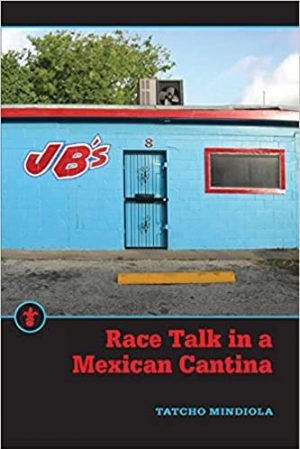A New Book by Tatcho Mindiola
Call it dando carrilla or echando mosca, Tatcho Mindiola takes the barrio art form of macho sarcastic digs and gives it new perspective in this ethnography of race talk in a particular Houston tavern. Traditionally, la mosca or el relajo was “a taunting, ribbing game, consisting of sparring insults, put-downs, and sarcastic digs, with a propensity to evolve into cruel and deprecating assaults on the other poor soul, who had to spar back with his own insults or risk being judged unmanly for not defending himself”.[1]
Mindiola captures authentic scenes of friendly barbs that are likely played out among middle-class men throughout the Southwest, but in particular in Texas. In the Houston cantina, at its core, the mosca relies on racial stereotypes. Race Talk in a Mexican Cantina inserts a white-brown racial element into the friendly ribbing games played out in a tavern in Houston’s second ward. What keeps the macho talk friendly, one suspects, is that the men (1) (white and brown) are of the same generation, (2) are generally engaged in or associated with work in which both groups perform similar work, and (3) have become friends over many years. Otherwise, the insults could easily turn to violence (see Chicanos Sparring on a Friday Night).
Thus, whites will point out stereotypes of Mexicans and vice versa. Consider the following:
“Some Meskin took my parking space” [by a white guy to his Mexican American buddies in the bar]
“you know what Shakespeare said?….a Mexican by any other name is still a Mexican.” [by a white guy to his Mexican American buddies in the bar]
“I know what you’re trying to do, you goat smeller,” JB tells White Mike. Mr. Charlie laughs. “Did you hear that? Mr. Charlie asks me. “Did you ever hear anyone call someone else a goat smeller? He laughs again. “That shit doesn’t bother me ole man,” White Mike says. “I taught him that and he turned it on me and has been calling me that ever since. Didn’t I teach you that JB?” “White boys haven’t taught me shit,” JB says, slamming down a domino, “especially a goat-smelling motherfucker like you.” We laugh. “Fuck you, partner,: White Mike responds in a congenial fashion.
Clearly, such jabs would be unacceptable in any other setting. Perhaps race talk in a beer joint serves the additional purpose of allowing the release of racial tensions, when stereotypical views can be joked about. As in the traditional mosca, the men, white and brown, instinctively know when their taunting has to stop, lest the next jab raises the bar beyond acceptance. And Mindiola points to several cases in which that occurs. Mindiola was able to gain entry into the group of men, some of whom have been engaging in the weekend, after work, social gatherings at the cantina for as many of 15 years. That up-close observation of the “research subjects” by the author makes the book especially authentic. The book is an easy and enjoyable read and an excellent reference for any student of sociology.
[1] From Ramirez, Chuy, Strawberry Fields, A Book of Short Stories






